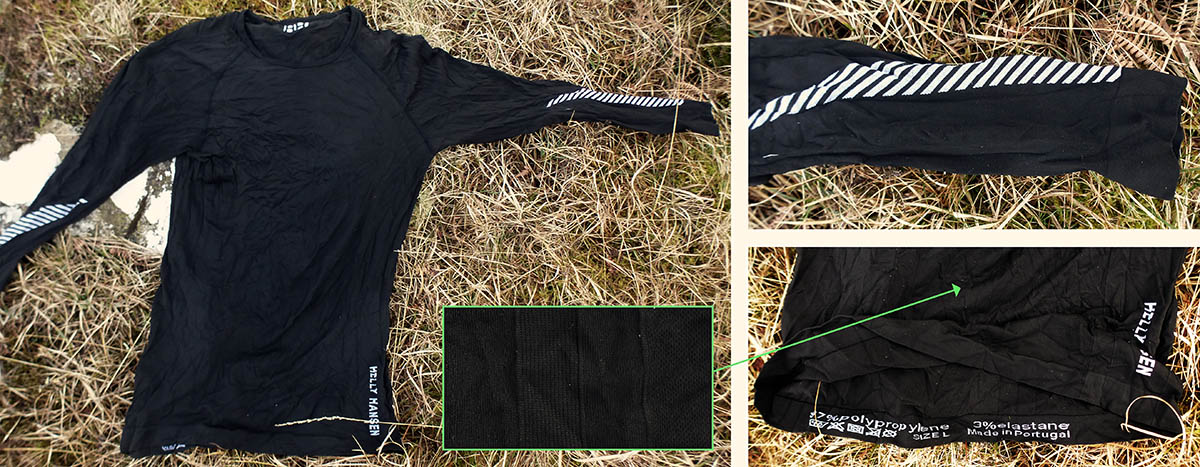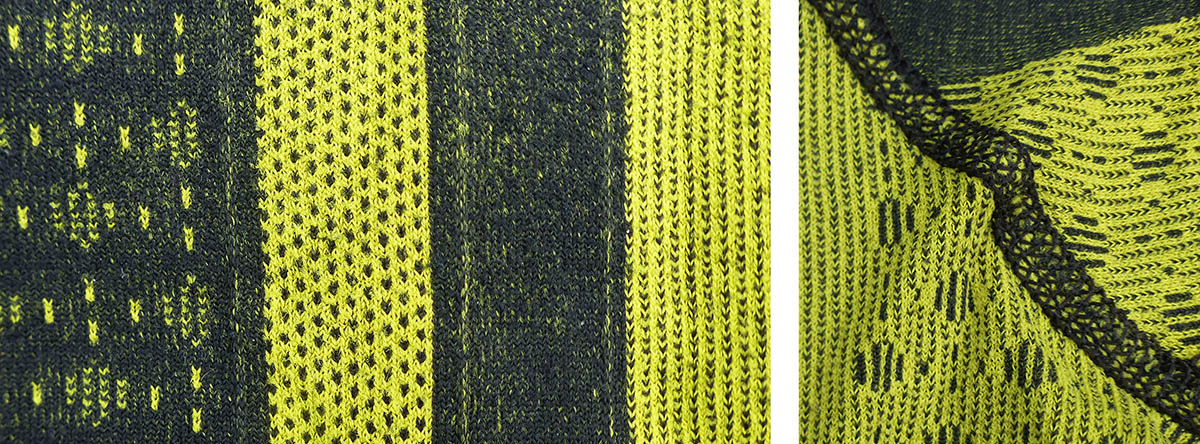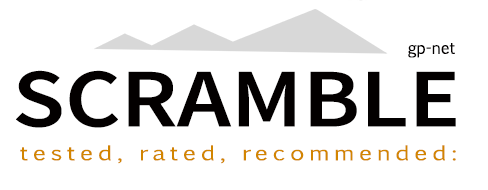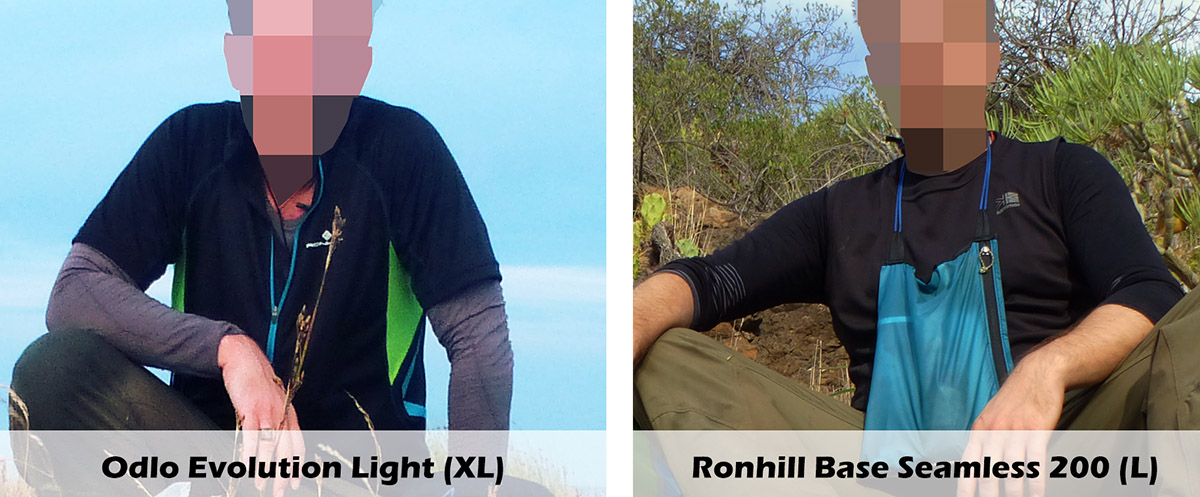This product has been toppled
Click on the image above or here to see its replacement.
Preface
Helly Hansen's Dry Revolution and Dry Elite baselayers are different releases of ostensibly the same item, with the Dry Elite 2.0 being the later release. There are some superficial differences but in terms of how they perform, sizing, comfort and price, they're the same: it's more about styling. For this reason we lump them together.
As always, we're looking at the Helly Hansen Dry Revolution and Elite 2.0 from the point of view of long distance trekking over tough terrain.
Test subject: Chest 42", Waist 33", Height: 5ft 8"
Test item: Size = Large and XL (for summer use - pic above is XL version, thus a little looser)
Kit Tests: Summer (multiple)
Disclaimer: None required (item not provided by manufacturer)
Datasheet
| Materials: Polypropylene / Elastane | 97% / 3% |
| Weight (Size Large) | 141g |
| Product Sizing Reference: 42" Chest = | Large |
| Manufacturer RRP | £50.00 |
| Scramble's Price on SYSTEM | £25.00 |
Scramble Review
Introduction: Thermo-Regulation
Probably the most important clothing layer, and perhaps the most under-appreciated, is the baselayer. The interface between our naked self and the outside world; the layer most responsible for how comfortable we feel in often uncomfortable surroundings and conditions.
The purpose of a baselayer is to move moisture and excess heat away from the skin and achieve a thermal balance that doesn't fluctuate too much throughout the day as conditions and activity levels vary.
"The closer the fabric the better the transfer of heat. Isn’t that a bad thing? No, the faster you can achieve thermal equilibrium with your base layers the less swift conduction will take place and a perfect micro climate can be achieved. This close layer will be highly efficient at stabilizing and re-establishing equilibrium if the user gets too hot or too cold and, gram for gram, will outperform a thicker but baggier inefficient layer. This is why a tight wetsuit is better than a baggy wet suit, even though both are full of potentially heat-sapping moisture. Stretch base layers are best, but most modern base layers are undermined by being too loose, being cut in order to pass as casual pieces." - Andy kirkpatrick (mountaineer)
So what do we want from a baselayer?
A stretchy, very close fitting, fast wicking, lightweight garment that is durable, comfortable (minimal seams and flatlocked to avoid chafing) with a non-synthetic feel. That's really the ideal.
Enter the Helly Hansen's Dry Revolution (and by extension the Dry Elite 2.0).
 Helly Hansen's Dry Revolution: label-free
Helly Hansen's Dry Revolution: label-free
Materials
The Dry Revolution is made predominantly of Polypropylene, a synthetic material constructed using long strings of lightweight hollow fibres; a thin and, like Polyester, very durable material. Polypropylene is hydrophobic, meaning it doesn't like water. This makes it an ideal wicking fabric, continuously moving sweat and moisture away from the skin to the less dense environment outside. Simply put, Polypropylene keeps you dry:
"A good example of a fast dry fabric is the Helly Hansen Lifa product, regarded by many as the best example of a stay dry base layer. [HH Dry Lifa garments] are renowned the world over and considered by many to be the most effective all season baselayers around." - Baselayer.co.uk.
We've tested numerous lightweight all-round baselayers, and we keep coming back to the HH Dry Revolution / Elite baselayers. The main reason is that they excel in all the important areas:
- ability to move moisture away from the skin
- ease of movement, stretch fabric makes an excellent second skin
- minimal number of seams (just at the arms and shoulders) and flatlock seam design means there is zero rub/chafing (and no labels either)
- very luxuriant and non-synthetic feel to the fabric, you really don't notice you're wearing it
- extremely comfortable and hard wearing for such a lightweight item
It's a little easier to see what's going on in Helly Hansen's Ebony version:
 Slightly pronounced elastication in the cuffs and at the hem, minimal flatlocked seams
Slightly pronounced elastication in the cuffs and at the hem, minimal flatlocked seams
Technicalities
The Dry Revolution utilises a complex array of weaves of varying densities to trap air in places, release heat in others and shift moisture all over. How much of this design is pragmatic and how much is technical aesthetics we're not sure. What is clear however, is that in total the baselayer works superbly well - so who cares?
 Helly Hansen's Dry Revolution weave: a close look at the back (left) and under arm / seams (right)
Helly Hansen's Dry Revolution weave: a close look at the back (left) and under arm / seams (right)
Recent Challengers
The last two baselayers we tested were both high quality items, but failed to dislodge the Helly Hansen baselayer:
The Ronhill Base Seamless 200 (L, 144g) is an excellent baselayer and I think, no longer in production. However, it felt a fraction warmer than the Dry Revolution, meaning it wasn't doing the thermo-regulating job as efficiently. Interestingly both tops are made in Portugal, but from different materials, the Base 200 is made from 75% Polyamide, 21% Polyester and 4% Elastane.
The Odlo Evolution Light (XL, 145g) had a more synthetic feel than both the Ronhill and Helly Hansen layers, and felt more clammy / spandexy. The Odlo Evolutions sizes small, requiring an XL, and is made of 77% Polyester, 18% Polyamide and 5% Elastane. So, that would suggest the higher Polyester and Elastane content is contributing to that synthetic clammy feel. To be clear, this is not a bad product at all, but it's noticeably inferior to the Dry Revolution.
Revolution! When's it good for?
We use this baselayer anytime we don't need a Cold Weather Baselayer, so the warmer sides of Spring and Autumn and throughout the Summer. Setting off in the early morning the temperature can be pretty cool, so we'll wear the Dry Revolution under a T-Shirt. We're generally not going to be wearing this at the hottest times of day, so it's important for such baselayers to be light and pack down small. At 140g you don't really notice the extra pack weight if you need to shed a layer.
Any Negatives?
We've been using these baselayers for around four years, and so far they've given us nothing to complain about. So no, not yet.
Conclusion & Rating
The Dry Revolution and Dry Elite 2.0 baselayers are masters at moving excess heat and sweat away from your skin. Stretchy, close fitting, fast wicking, lightweight, surprisingly durable and supremely comfortable, they're a joy to wear and the baselayers that for us have set the standard against which all competing baselayers will be judged. Our top pick in the Lightweight Baselayer category - we just hope Helly Hansen continue to produce them.
Product Images (Dry Elite 2.0 in Blue, Dry Revolution in Black)
Rating (out of 10)
* The value score is derived from two factors:
1) Competitive Market Price (CMP). This represents our judgement of a competitive online price point if we were to stock the item. e.g. if we feel we would need to sell an item at 40% off (i.e. 60% of its full RRP) to be competitive, then our CMP score will be 6/10.
2) Customer Value Price (CVP). We then make an honest appraisal of the maximum price we would be willing to pay for the item (and we're mean). So if we'd pay 80% of its RRP our CVP score would be 8/10.
We then average the two scores to get our final value score, which in our example would be 7/10.
Last Updated: 01/11/18
















